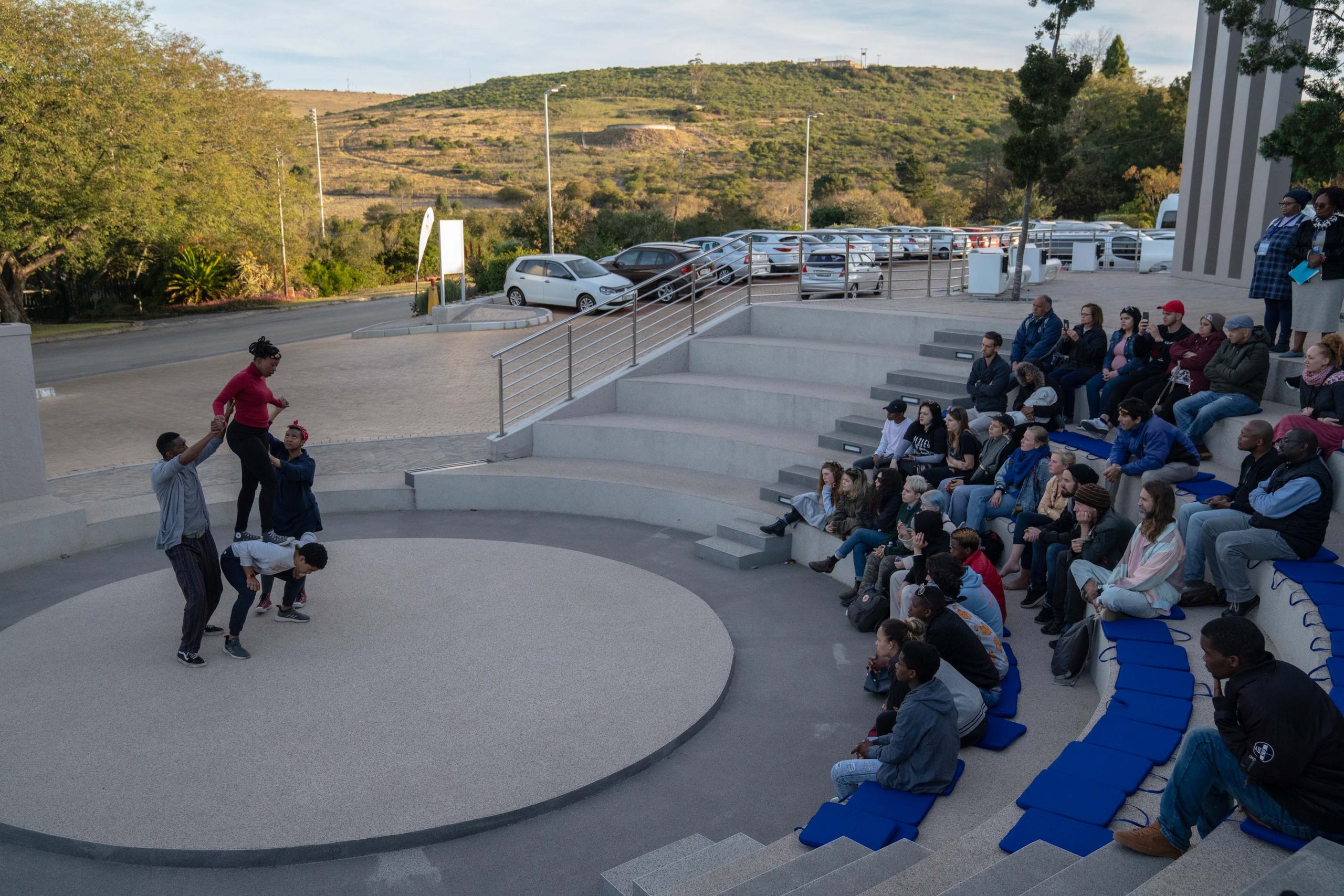The fringe festival, a worn out model for Makhanda
The National Arts Festival Fringe has always showcased innovative and experimental work, but new artists in particular are struggling to earn or losing money on their productions.
Author:
7 July 2019

“This is a state of emergency!” declares Lerato Sefoloshe. Agitated and determined, Sefoloshe and her castmates move back and forth across the Amazwi outdoor amphitheatre at this year’s National Arts Festival in Makhanda repeating these words.
“I don’t want your hope, I want your panic,” they signal the urgency of the global environmental crisis to a young audience.
Sefoloshe is one of four cast members – alongside Jaques de Silva, Sanelisiwe Yekani and Mlindeli Zondi – performing a protest poem titled Burning Rebellion. Joni Barnard directs the poem, one of four productions brought to the festival by Johannesburg’s Well Worn Theatre Company.
The company was born out of artistic director Kyla Davis’ passion for environmental activism and theatre. It is a collective of directors and physical theatre performers who are interested in creating edutainment about the effects of climate change and pollution in South Africa for a predominantly young audience.
The National Lotteries Commission currently funds Well Worn. This year, the company has four productions on the main festival programme: Rat Race, Galela, Plastocracy and Burning Rebellion.
Davis says this is quite a departure from the fringe stage she has occupied over the past 10 years. “I am amazed that we cracked it on the main festival this year,” she laughs sardonically.

No payoff out on the fringe
The National Arts Festival Fringe programme has always featured innovative and experimental work. This aspect of the festival mirrors the Edinburgh Festival Fringe in Scotland, which began in 1947 when eight theatre companies performed their work uninvited alongside the official International Festival. But Davis says there are few benefits for independent theatre makers to take part in this tradition of the National Arts Festival.
“There’s just no payoff,” she adds. “Other than for a minority of practitioners who do really well on the fringe, the general experience for fringe theatre makers is that they lose money. This is a direct consequence of there simply being too many theatre offerings for the size of the market.
“As artists, we are being asked to bring the work, the funds, the audience, because, let’s be honest, everyone who watches fringe shows are fringe artists themselves. It’s become ‘you come see my show and I will come see yours’, because at the very least, we want an audience,” says Davis.
Related article:
“That’s their big promise always. They say that fringe artists should come and take a risk, but in reality all the risk is on the artists. They say come and take a risk and meet producers and meet international producers and international festivals and sell your work. It’s starting to feel like an empty promise. In my opinion, those festivals and those international producers have already been tipped. It can feel very in-house,” continues Davis.
“Last year we made a R40 000 deficit and the only way that I have been able to go to the festival this time is because of lottery funding. My accommodation bill this year is R50 000. I am accommodating five artists for the whole period. Some people are also accommodating themselves and I am contributing, so that’s not even the whole bill.
“So, this idea that we have to trek all of our sets and props to Makhanda for the fringe festival to have a platform is a myth that is quickly losing its mysticism,” she says.

A Manichean festival
“When festival arrives, there is this beautification of Makhanda where the [festival organisers] put the sawdust down [at the Village Green market] and the posters up, and then all that ends just as quickly as it arrived. After it’s over, where is the legacy of the festival?” asks Davis.
She says her sense of the festival organisers’ efforts at engaging with the residents of Makhanda, working with the Fingo Festival held in Joza Township, is that they are “very separate, totally forgotten, last-minute and inauthentic. There is no authentic development and integration and inclusion, and no real audience development, to be honest. There is not even transport. The simplest thing to do would be to have a bus from Joza daily to town.
“You only have to take a walk to the Village Green [market] for an afternoon and then take a five-minute walk to the Checkers on Beaufort Street and see who is where. There is extraordinary disparity and inequality and a real disconnect from the participants of the festival and the inhabitants of Makhanda.”

Fringe in decline
“Unless you are comedy, magic or funded, nobody is making money on the fringe anymore,” says Davis.
“There’s been a definite downturn,” says longtime actor and performer Rob van Vuuren on the lawn of Victoria Girls’ High School, between the tents of the Village Green market. “There’s less people going to less shows, which I think is just a byproduct of the times we are living in.
“It’s getting harder and harder for both audiences and artists to come to this festival. While ticket prices have remained the same, accommodation and food has skyrocketed. So as an artist or someone who is travelling to the festival with your family or whatever, there’s just less that you can see. There is less that you can do and a shorter time that you can stay for, for so much money.
“I’ve been doing this festival for so long that I have figured out a way to make it work for me and make a body of work that is diverse enough that I can make some money off the festival and play to different audiences and build up enough credibility to draw a variety of different audiences. That has helped me survive this festival, because then I can spread my costs of accommodation and travel, food and any salaries I might be paying across those shows.
“I have noticed a huge shrink over the last couple of years. I don’t see how someone who is doing it for their first time, who doesn’t have a brand and an audience and only has one show with a cast of three or four people can sustainably afford the festival.
“I really worry about that … [new] artists are just losing money,” he says, his voice trailing off.

